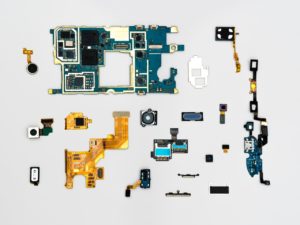
Inside Your Phone: How Your Smartphone Touch Screen Works
I think using the touch screen on our smartphone devices has become like breathing at this point. It’s almost second nature. Rarely do we actually think about what goes on behind the screen. As simple as it is to use a touch screen, the processes that take place on the other end are rather complex. There are a plethora of different ways that a touch screen can be engineered. You have infrared, surface acoustic wave, and even near-field imaging. We will discuss two of the most popular and most common methods used today in this article, as well as the fundamental layers of the display.
The 3 Main Layers of the Touch Screen
When you first look at a display screen, you automatically think of it as one singular piece. However, it is actually multiple pieces working as one cohesive whole. The top glass is the layer that users are most familiar with. It is the layer you actually touch. We spend a majority of our time engaging with the graphical user interface (GUI) by touching the top glass. Clicking on apps, sending text messages, e-mails, etc. Right underneath that layer is the responsive grid that makes the magic happen. This responsive layer is often referred to as the digitizer. You can basically say the digitizer puts the actual touch in the touch screen. The bottom-most part is probably the most expensive, fragile, and overall critical component of the display: the Liquid Crystal Display (LCD) does exactly what its name implies. Its primary role is to display the image on the screen. All of these parts work in conjunction to achieve the desired result of a functional touch screen. Now that we have that covered we can talk about the different methods applied to create the touch screen effect.
Resistive Technology
Have you ever used a drive-up atm? How about the GPS screen installed in your car? If you answered yes, which you most likely did, then you have used a touch screen that relies on the resistive technology. This technology relies on two layers that conduct electricity bending together and touching. One layers has a negative charge and the other layer has a positive charge. When you touch the screen, you are applying pressure and causing these screens to interact with one another. When these two layers meet they create a change in current, which is recognized by the software. The software then in turn relays that information and carries out the action required based off of the coordinates given. This method isn’t optimal for modern phone screens, mainly because they do not allow the multi-touch function. Only one point of contact can be registered at a time. Therefore, you would not be able to use both fingers to expand the screen on your smartphone device, which is becoming more and more of a necessity in the era of mobile phone web browsing. Which brings us to the next method we will talk about.
Capacitive Technology
Instead of using pressure, this method focuses on charge. It utilizes anything that is conductive, such as your finger. Yes I know it’s weird hearing it, but you yourself are a conductor. The human body is chemistry in motion. We are made up of atoms both positive and negative and are a vital component in allowing this method to work. Basically, the point of contact that was determined by the pressure from your finger in the last scenario, is determined by the charge of your finger in this scenario. That charge from your finger creates a change in the current and is registered via the software and relayed. This technology has been adopted as the most popular method applied to touch screens on modern smartphone devices. Capacitive screens not only allow you to use the multi-touch function, but also display a sharper image and are more durable than the resistive touch screen, making them the overall better option.
Hopefully, this article gave you a greater understanding of the concept behind touch screen technology in an informative way that didn’t overwhelm you with technical jargon. Of course we could have gone deeper into the details, but this is a sufficient start to understand whats going on inside your smartphone!
If you have any questions regarding your device or about any information covered in this article feel free to reach out to us! You can reach us at (919) 263-2699 or schedule an appointment! If you have friends that need a repair you can sign up for our referral program. You make $5 for every person you send to TCR and they save $5 on their repair as well!
